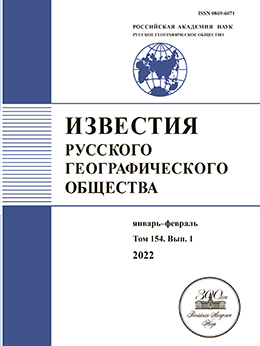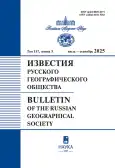Известия Русского географического общества
Cтарейший географический журнал России и один из авторитетных научных географических журналов мира; издается с 1865 г.
Структура журнала включает: оригинальные статьи, отражающие результаты новейших географических исследований; дискуссии; рецензии; хронику.
Свидетельство о регистрации СМИ: № 0110279 от 08.02.1993
Учредители
- Российская академия наук
- Русское географическое общество РАН
- Институт озероведения Российской академии наук
Главный редактор
- Касимов Николай Сергеевич, академик РАН, доктор географических наук, профессор
Периодичность / доступ
4 выпуска в год / подписка
Входит в
Белый список (3 уровень), перечень ВАК (К1), РИНЦ, ядро РИНЦ, RSCI
«Известия Русского географического общества» предоставляет трибуну для обсуждения актуальных проблем, сложных и дискуссионных вопросов географической науки. Предпочтение отдается статьям и сообщениям, содержание которых может представлять интерес для широкого круга специалистов-географов и представителей смежных дисциплин. Редакционная коллегия поддерживает перспективные направления в географии, в особенности работы по проблемам рационализации природопользования, сохранения природного разнообразия, регионального развития и пространственной организации общества, а также междисциплинарные исследования на стыке географии и других естественных и гуманитарных наук.
Система научного рецензирования и редактирования, принятая редколлегией журнала, обеспечивает высокий уровень публикуемых материалов и соответствие их профессиональным критериям.
Текущий выпуск
Том 157, № 3 (2025)
Статьи
Тематическая классификация лесных карт и методологические основы их создания
Аннотация
 247-267
247-267


Новые сведения о позднеголоценовых изменениях уровня Ладожского озера в Южном Приладожье
Аннотация
 268-287
268-287


Чувствительность фитопродукционного процесса в низкогорно-степных ландшафтах Южного Урала к флуктуациям гидротермического режима
Аннотация
 288-304
288-304


Интегральная оценка опасности размывов берегов рек Западной Сибири
Аннотация
 305-316
305-316


Морфодинамика русла р. Северной Двины, его естественные и техногенные трансформации в XX–начале XXI в.
Аннотация
 317-339
317-339


Расчет предельно допустимой рекреационной емкости территории природного парка “Белуха”
Аннотация
 340-358
340-358


Дружественность и недружественность стран мира как фактор современного геополитического положения России и Сибири
Аннотация
 359-378
359-378


Перспективы использования возобновляемых источников энергии на севере Красноярского края
Аннотация
 379-393
379-393


Природно-антропогенные изменения стока наносов рек в бассейне Индигирки
Аннотация
 394-415
394-415


О строительном камне псковских земель в эпоху Средневековья
Аннотация
 416-433
416-433


Наводнение на побережье полуострова Камчатка 14–15 декабря 2023 г.
Аннотация
 434-450
434-450


Региональные различия в накоплении запасов произведенных черных металлов и металлолома в экономике России
Аннотация
 451-465
451-465










